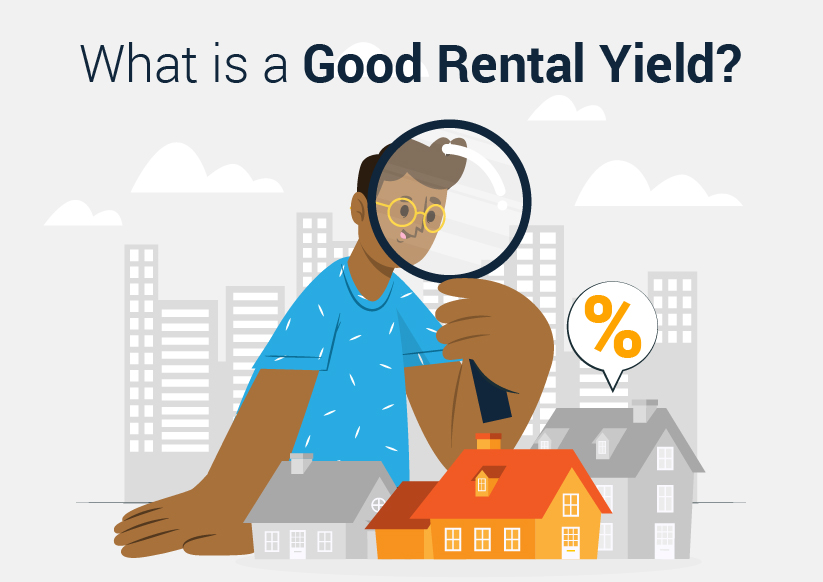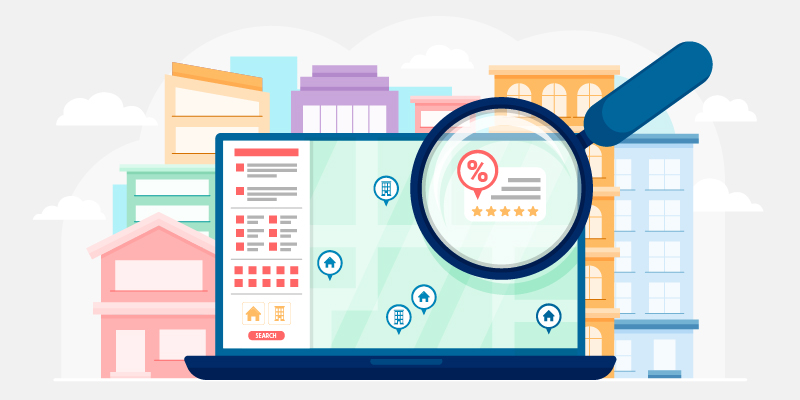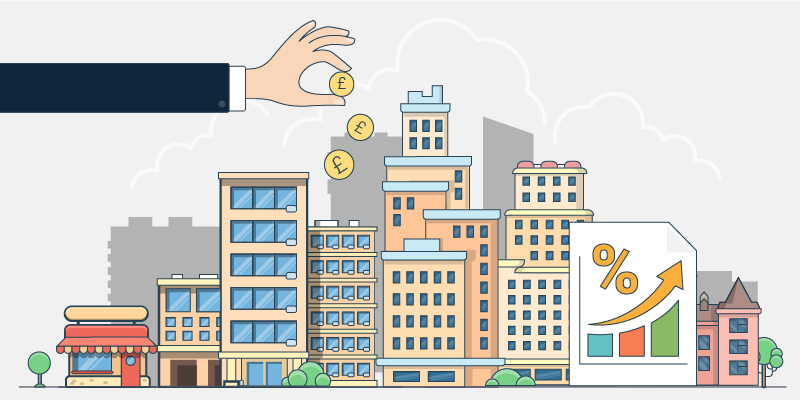What is a Good Rental Yield?

When it comes to investing in property, getting a decent rental yield is one of the most important factors for an investor. No matter the type of property you invest in, you want to be sure that the monthly rental income can cover the property’s outgoings and expenses while still generating profit.
In this article we take a look at what is a good rental yield, how to calculate rental yield, the ways landlords can potentially boost the rental yield of a property and cities in the UK which are offering strong rental yields both right now and in the future.
What is Rental Yield and why is it Important to Property Investors?
Rental yield is the rental return an investor will achieve on a property through rent on an annual basis. Rental yield is always calculated as a percentage by dividing the rental income by the price paid for the property.
For property investors, ensuring a property delivers a good rental yield is of paramount importance. A savvy investor will use the monthly rental income to cover the property’s running costs. These expenditures can include mortgage repayments, property maintenance, taxes and fees and other expenses associated with owning a property. If monthly rental income falls short of costs, landlords will lose money. Ideally, any investment property should be a sustainable investment, and ensuring a property can pay for itself month to month is one of the key aspects of building a solid investment portfolio.
A good rental yield is also important for capital growth. A property with a high rental yield will have more potential to appreciate in value over time, and when combined with a low purchase price, it can provide an investor with the opportunity to make a sizeable return on their initial investment.
Ultimately, rental yield is an essential element of any successful property investment strategy and should be considered carefully before committing to any purchase. It’s important for investors to weigh up the risks and rewards of any potential property investment and understand how rental yield can affect the long-term performance of their portfolio.

What is a Good Rental Yield in the UK?
As mentioned, ideally, rental yield will generate enough monthly cash flow to cover ongoing expenses like mortgage payments, running costs, management fees, buy-to-let landlord insurance, repairs and any unforeseen expenses that can crop up. Generally a good average yield for a UK buy-to-let property is 5% or higher. If the monthly rental yield falls below this percentage, it can be difficult for landlords to cover expenses which might lead to an investment going into the red. This figure can be higher or lower depending on the specific property, location and market conditions. For example, properties in areas of high demand may have higher yields than those in less desirable locations.
This is why it’s so important to undertake extensive research before making any investment in a property, being sure that average rental returns make sense in comparison to the property cost.
Sometimes, a rental property can present investors with the unexpected. The higher the rental yield, the more sustainable your property is likely to be in the long term. A higher rental yield – something closer to 8% – would give investors a contingency budget should costs increase with little warning.
While areas that have strong capital growth or where you can find a good deal can be extremely tempting, for a sustainable investment, ensuring monthly rental return can, at the very least, cover baseline costs is extremely important. Prioritising capital growth over monthly returns may make a property become a less than profitable investment.
What is a Good Rental Yield? Student Property Yields
Student property is often on the radar for buy-to-let investors due to the potentially lucrative yields on offer. In many university towns, student properties are located on the outskirts of city centres or on the edge of campuses where property prices are more affordable. At the same time, students typically pay higher rent than other tenants, which can make yields significantly greater. In some student cities, the right shared student rental property can generate yields of up to 20% higher than average property due to the lower house prices.
However, with student rentals, landlords may need to take some other costs into consideration when working out whether the rental yield makes the investment worth it. Landlords will need to look for new tenants more regularly, consider any advertising costs, letting fees as well as potential void periods into their investment. Student properties also tend to demand more maintenance and upkeep from wear and tear, costs that landlords should ensure the monthly rental income will cover.
Overall, student rental properties can offer great returns for investors if done correctly. With the right research and preparation, investors can find an attractive yield with student rentals that will help them achieve their investment goals.

What is a Good Rental Yield? Residential Property
Student and residential property can come with different price points, and just because a student property offers a higher yield may not always mean it will make a superior investment.
For example, a residential property may deliver far higher house price growth in the future, meaning the even capital gains delivers a higher level of profit than the ongoing monthly rent of a student property. A minimum of 6% yield is a good investment for a residential property, and if a property is located in a city undergoing rapid redevelopment that generally signals a strong return when it comes to the sale. Investors will need to carefully do the math to decide what type of investment is right for them.
Ultimately, investors should assess their individual investment goals and objectives when assessing what is a good rental yield for their particular situation.
How do you Calculate a Property’s Rental yield?
The rental yield of a property is a key metric for evaluating the potential return on investment for any real estate purchase. To calculate the rental yield on a property, you need to take the annual rental income the property will generate then divide it by the price paid for the property before multiplying the figure by 100. As an example, a rental property bought for £200,000 and bringing in annual rental income of £10,000 would have a 5% rental yield. Rather than doing the hard math, you can use an online rental yield calculator tool to quickly work out the rental yield on a property.
Calculating rental yield using rent and purchase price is the most basic way to calculate the rental yield of a property. This gives you an idea of gross rental yield – everything before the expenses. However, calculating the net rental yield of a property will give you a much more accurate view of your investment, because it takes into account outgoings to give you the rental yield after expenses. While gross rental yields are easier to calculate, they can make the yields appear higher than they actually are. Investors should be sure to calculate the net yield of a property, taking into account monthly outgoings and expenses such as agency fees, maintenance, tax, insurance, mortgage costs etc. to get a clear picture. It’s important to factor these costs into your calculations when assessing potential ROI on an investment property. A good net rental yield should be between 5-7 %, which will ensure you are still making a decent return on your property after the usual outgoing payments.

How can Investors Maximise Rental Yield?
What are some of the ways landlords can maximise rental yields on a property to ensure that it generates the highest yield possible?
Maximising rental yield begins by buying a property for as low price as possible. Some property investment advisors will be able to guide you on off-plan properties – those that are being offered at below market value. While you will usually need to wait for a property to be completed, buying an off-plan property reduces the property cost to a minimum.
The next step is to get the monthly rental value of your property professionally assessed. A surveyor can assess the current rental market for the area, the value of your property and whether it makes sense to increase rent before the next tenant in line with local rent rises. While landlords can’t increase rent on a whim, by investing in an area with strong rental demand, there’s a higher chance you’ll be able to boost rental yields and monthly income. If a property is located in an area with good infrastructure, employment opportunities and amenities then it is likely to appreciate in value over time.
Another way to maximise the rental yield of a property is to undertake renovations and updates to make it more appealing and competitive in the rental market. Pay attention to key features tenants are looking for and how you can give your property assets others in the area don’t have to make it more sought-after. Higher rental value can be delivered by installing a modern kitchen and bathroom, fresh decor and investing in a property with outdoor space like a garden, or a spare room for a home office.
Upgrading fixtures and fittings can also help to maximise rental yield. This includes modernising the electrical system, installing energy-efficient appliances, or investing in smart technology such as heating and lighting systems that can be remotely controlled. Tenants are often willing to pay a premium for these features so it’s worth considering them when renovating a property.
What are the Best Rental Yields in UK in 2023?
Rental yields vary by location and just because one area of the UK has high monthly rent, doesn’t necessarily mean that a property will be more profitable and deliver higher yields. For example, while London has the highest rent of anywhere in the UK – the average monthly rent sitting at around £2,700 – the average property price is close to £950,000. This means the yields are only around 3.4%.
In contrast, in a city like Liverpool, while average rent is around £800, the average property price is £160,000, making the rental yield 6%. Also taking into account that work to undertake maintenance fees in a city like London is likely to come at a premium, compared to London, properties in Liverpool can perform much better due to the significantly higher rental yields on offer.
Let’s take a look at some of the areas of the UK offering strong rental yields in 2023 and beyond.

Liverpool
Liverpool currently has the highest rental yields in the country. While net rental yields of 5-7% are sought after, in the L1 postcode in the city centre, some properties generate 10% rental yields. Liverpool has plenty of relatively cheap-to-purchase property, and with the rapid regeneration transforming the city, it’s becoming a more sought after destination boosting rental rates and demand. At the same time, Liverpool has a thriving student scene, and investing in a student property close to its campuses can increase a landlord’s potential to generate more lucrative rental yields.
Find out more about what is boosting Liverpool’s rental yields.
Manchester
Another much sought after city in the North, Manchester presents an attractive rental yield return. Manchester is set to see both the highest sales price and rental growth of any UK city – the average value of property in Manchester through 2024 is set to grow by 17.1% and average rents in Manchester sit at around £1,115 per calendar month. Our new Manchester Waters property is set to offer landlords rental yields predicted to reach 6%.
Find out more about what is contributing to Manchester’s growing rental yields.

Leeds
Alongside Manchester, Leeds also offers highly attractive rental yields and it’s one of the most popular UK cities for student rentals. Average yields in the city currently sit at around 4.29% and by 2024, rents are tipped to rise 18.8%. One of our properties, Sky Gardens in the much sought-after Southbank district can be had for 15% discount, giving investors a lower purchase property price and possibility to boost the property’s rental yields.
Find out more about why properties in Leeds have strong rental yield potential.

Nottingham
Rental yields in Nottingham have been growing for some time, and the city is becoming increasingly popular with property investors. In the city centre, asking rents have grown by 6.8% in the past year and average property prices are around £111,103. Rents present landlords with potential for monthly returns thanks to competitive yields. One property not to miss out on is The Wells Nottingham. This city centre boutique development is set to benefit from the city’s thriving and undersupplied rental market, and yields are predicted to hit 7.5%.
Find out more about what is boosting rental yields in Nottingham.

Birmingham
Birmingham recently topped the chart as the UK city landlords were most likely to invest in in 2023. Property prices remain relatively low compared to other cities in the UK and in 2023, rental yields hit an average of 5.5%. Going forward rents are expected to continue to rise, and could reach the highest of any city in the UK – some predictions put rental yields in Birmingham at 12% over the next 5 years.
Find out more about why rental yields in Birmingham are predicted to rise.
When it comes to uncovering what is a good rental yield, investors need to take a few factors into consideration. Before investing in any buy-to-let property they should be aware of the difference between gross and net rental yield and what this means for their property. High monthly rents don’t necessarily mean high yields, and finding an area where property prices are relatively low and where they can secure decent rent is a must. For landlords willing to invest some time and money, they may be able to boost the rental yield of a property by making improvements and ensuring their property offers sought-after assets over others in the local market. To find out more about where you can secure a property with a good rental yield in the UK, get in touch with our experts.


